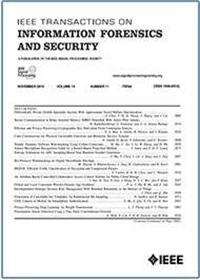基于生成对抗网络的CCRNs协同干扰隐蔽通信
IF 8
1区 计算机科学
Q1 COMPUTER SCIENCE, THEORY & METHODS
IEEE Transactions on Information Forensics and Security
Pub Date : 2025-01-03
DOI:10.1109/TIFS.2025.3526058
引用次数: 0
摘要
本文研究了一种集中式协同认知无线网络(CCRN),其中主基站(PBS)向主用户发送消息,而辅助用户发射机(SU-Tx)充当友好干扰器。干扰器发送干扰信号来保护PBS的信息不被潜在的窃听者(夏娃)窃取。但是,SU-Tx也试图使用分配的频谱资源将自己的消息秘密地发送给辅助用户接收器,这违反了PBS规则。为了解决这个问题,PBS要求其合作伙伴CBS帮助检测干扰者的行为。具体而言,我们提出了一个生成对抗网络(GAN)优化框架,该框架模拟了协作干扰机的CBS监控和隐蔽传输之间的战略博弈。我们介绍了一种新的基于gan的波束形成设计算法,称为GAN-BD,用于确定隐蔽通信干扰机的功率分配。此外,我们开发了检测误差概率(DEP)在CBS和导出其表达式使用假设检验问题。通过广泛的仿真结果,我们证明了所提出的GAN-BD算法可以实现进行隐蔽通信的近最佳解决方案,利用当前网络环境的知识并表现出快速收敛能力。仿真结果验证了GAN-BD算法的有效性。本文章由计算机程序翻译,如有差异,请以英文原文为准。
Generative Adversarial Network-Aided Covert Communication for Cooperative Jammers in CCRNs
This paper investigates a centralized cooperative cognitive radio network (CCRN) where a primary base station (PBS) transmits a message to a primary user while a secondary user transmitter (SU-Tx) function as a friendly jammer. The jammer sends jamming signals to protect the PBS’s messages from a potential eavesdropper (Eve). However, the SU-Tx also attempts to covertly transmit its own messages to a secondary user receiver using the allocated spectrum resource, contravening the PBS regulations. To address this issue, the PBS requests its partner CBS to help detect jammer’s behavior. Specifically, we propose a generative adversarial network (GAN) optimization framework that models the strategic game between the CBS monitoring and the covert transmission of cooperative jammers. We introduce a novel GAN-based beamforming design algorithm, termed GAN-BD, to determine the power allocation at the jammer for covert communication. Additionally, we develop the detection error probability (DEP) at the CBS and derive its expression using a hypothesis testing problem. Through extensive simulation results, we demonstrate that the proposed GAN-BD algorithm can achieve near-optimal solutions for conducting covert communication, leveraging knowledge of the current network environment and exhibiting rapid convergence capabilities. The simulation results highlight the effectiveness of our GAN-BD algorithm.
求助全文
通过发布文献求助,成功后即可免费获取论文全文。
去求助
来源期刊

IEEE Transactions on Information Forensics and Security
工程技术-工程:电子与电气
CiteScore
14.40
自引率
7.40%
发文量
234
审稿时长
6.5 months
期刊介绍:
The IEEE Transactions on Information Forensics and Security covers the sciences, technologies, and applications relating to information forensics, information security, biometrics, surveillance and systems applications that incorporate these features
 求助内容:
求助内容: 应助结果提醒方式:
应助结果提醒方式:


